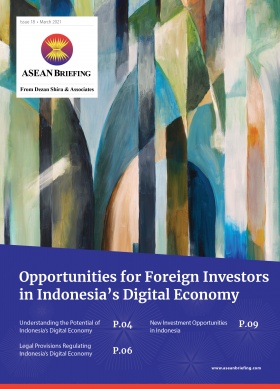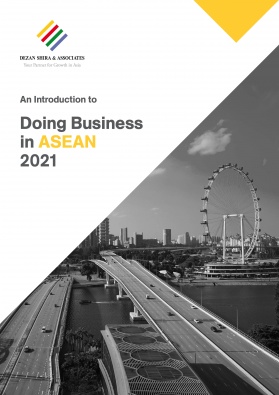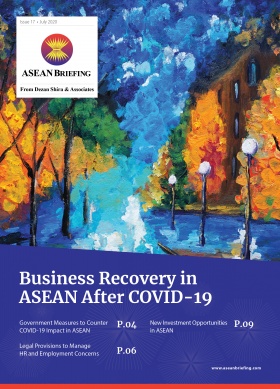Russian Outbound Investment into ASEAN & Southeast Asia
Infrastructure developments and free trade agreements are having a slow, yet positive impact on Russian investments in Asia.
Op/ed by Chris Devonshire-Ellis & Maria Kotova
Over the past decade, Russia has begun to emerge as an increasingly important military player in Southeast Asia – it is the region’s largest arms exporter. However, much of Russia’s economic cooperation in the region has flown under the radar or been dismissed as trivial. In this article, we explore the new trends and rivers of Russian overseas direct investments (ODI) into Southeast Asia and ASEAN.
Russian ODI to China and Hong Kong
We include China and Hong Kong in this report as Hong Kong is important in the context of Southeast Asia – it serves much of the ASEAN region and beyond. This is augmented by other mainland Chinese Ports in Southwest China’s Guangxi Province which provide corridors from Central and Western China – including soon from Siberia – and onto ASEAN.
According to the Bank of Russia, in 2018-19 and for mainland China, ODI increased from US$254 million to US$284 million, a rise of 11 percent. Hong Kong received more ODI than China itself, up to US$341 million from US$323 million, also an increase of 11 percent, primarily due to the Russia-Hong Kong Double Tax Agreement which was entered into in 2017 and its use as a services hub for China.
These statistics are consistent with reports from mainland China customs and the Russian Ministry of Commerce which have both been suggesting that bilateral trade has been increasing at amounts of about 20 percent per annum with a residual portion of this resurfacing as trade investment into China. Both Governments have expressed a desire to double trade volumes to US$200 billion by 2024, on current performance this looks feasible. This would be further enhanced if China completes negotiations over tariff reductions with the Eurasian Economic Union (EAEU), which includes Russia, and which China signed an FTA within 2018.
Russian ODI into ASEAN
In terms of ASEAN overall for the same period 2018-19, Russian ODI into the region reached US$699 million from US$654 million a year earlier, an increase of just under 5 percent. The bulk of this went to Thailand, with investments of US$689 million. Other growing investment destinations in ASEAN were Singapore, with a huge increase to US$11 million from US$3 million the previous year, while Indonesia and Vietnam also performed well, with a small increase of ODI in Cambodia. Singapore signed off an FTA with the EAEU in 2019 while nearly all other ASEAN nations are in negotiation with Moscow. ODI into ASEAN is however on an upwards trend, with plenty of room for growth.
However, Russian investors are conservative and largely risk-averse, they tend to invest once trade confidence and local market intelligence reach a certain platform, then they tend to commit more. We feel we are at the edge of that lip, and ODI will increase especially when EAEU FTA is signed off. A large portion of Russian ODI has gone into Thailand which will become a hub for the development of ODI further into the region; we are already seeing this with Vietnam and Cambodia. Another sign this is occurring is the increase of Russian ODI into Singapore, which is a regional services hub for ASEAN.It remains easier for Russian investors to establish bank accounts in Singapore than it is in Hong Kong, where Chinese banks are more reluctant to take on any risks viz-a-viz US sanctions on Russia. Singapore is generally regarded by the US as having a better KYC discipline and consequently, it is easier for Russian companies to invest there.
Singapore and Vietnam’s Russian free trade experience
Both Singapore and Vietnam have signed Free Trade Agreements with the Eurasian Economic Union. These FTA include Armenia, Belarus, Kazakhstan, and Kyrgyzstan in addition to Russia, although the latter is the dominant market.
Together these represent a consumer market of about 180 million people, with about 60 million representing middle-class consumer spending power. However, per capita income is increasing across the board in all these markets. The EAEU also has an average per capita income (actual) of US$9,500, which is about 22 percent higher than China’s average.
These FTA cover a wide range of goods and differ from country to country. However, it should be noted that about 90 percent of these include non-energy products – Russia is often thought of as a Petro-state but its share of non-energy income has been growing and is now at 30 percent of total GDP. These FTA encourage this development and concentrate on other, non-energy products such as agriculture, machinery, and other items related to a wide array of manufacturing components including for the auto, electronics, and computer industries. In the case of Vietnam, this has also been accompanied by an increase in Russian ODI in the country. Russia’s investment into Vietnam increased from practically zero to US$10 billion in two years after the Vietnam-EAEU FTA was signed.
Singapore as mentioned is more a service play for Russian companies investing elsewhere in ASEAN and especially Thailand, although Indonesia is also looking increasingly attractive to Russian investors. Singapore has a Double Tax Treaty with Russia that helps with certain profit enhancement tax structuring and has free trade with ASEAN, as well as China and India. Singapore also does not charge income taxes on profits realized externally from its borders. Once Russian investors have grown more confident and started to better understand the regional and trade dynamics, Singapore will become a larger driver of Russian ODI into ASEAN, in addition to China, India, and the RCEP nations which also include Australia, New Zealand, Japan, and South Korea. This will take time, but it is starting to move in this direction.
The EAEU and Southeast Asia
Vietnam’s experience has spurred renewed interest from ASEAN nations concerning EAEU FTA as a result. It is a little early to provide data concerning Singapore as the FTA was only signed off just before Covid and this has delayed any immediate ODI reaction as Russian investors put plans on hold to deal with protecting their domestic markets and investments – as most businesses have done.
That hasn’t stopped the diplomatic trade efforts, however. In ASEAN, in late 2019 Singaporean Prime Minister Lee Hsien Loong stated he believed a full FTA between all ASEAN states (Brunei, Cambodia, Indonesia, Laos, Malaysia, Myanmar, Philippines, Singapore, Thailand, and Vietnam) and the EAEU should occur. That is already partially on track; Cambodia, Indonesia, and Thailand are all in negotiations. The Philippines has stated interest. In East Asia, South Korea has stated it wants a fast-track FTA deal. In South Asia, Bangladesh, India, and Pakistan are all currently negotiating, while Iran signed off a provisional three-year trade deal in 2018 and is about to renew this.
Asian antipathy towards Russia
There are however hurdles to overcome, not least of perception. Many analysts believe that Russia doesn’t have all that much to offer Asia economically, and its engagement with the region will remain lackluster.
We think this is a short-term view based on a lack of knowledge and Western media bias – Russia, in particular, is positioned with a high degree of negativity in the West, and this impacts perceptions. Russia also seems rather a long way from Asia when countries such as China, India, and Japan all tend to dominate thoughts and headlines.
That said, it should be noted that the Russian Far East is relatively close. Vladivostok is a major port and just a three-hour flight from Shanghai and just over two hours from Tokyo – it is easily accessible and offers access to Central Asia, Eastern Europe, and to markets in the EU. Transshipments across Russia to the EU from Vladivostok cut 50 percent off delivery times using the alternative Suez route and take 12 instead of 30-45 days. These economic indicators will refocus attention away from the traditional method of exporting goods to involving Russia’s North-East Asian ports, and if this becomes more economically viable to use them then ASEAN manufacturing exporters will do so.
It should also be remembered that the EAEU itself is not, as competitive or demanding as for example, the European Union has become. Although Russia is a sizeable manufacturer, and the largest member of the EAEU, it does not have the massive export push of competitive products that frightens so many small-medium sized countries when it comes to free trade with China.
The EAEU then sits in a comfort zone, offering less domestic intrusion to manufacturers in other countries, while at the same time offering access to an EAEU market of close to 180 million, a sizeable prize for many of these smaller nations. Such agreements also work for Russia and the EAEU; able to partner with new investors, exchange products and technologies, and helping develop a Central Asian region with new infrastructure being put in place, such as the International North-South Transport Corridor.
a multi-modal route that provides much-improved access from India and Pakistan and gives access to markets in Iran, Central Asia, the Caucasus, Turkey, and Russia itself. It is this combination of new, more economic, and time-saving routes, together with EAEU free trade agreements that will, over the coming few years begin to develop Southeast Asian interest in these new markets and new investments being made.
Connecting Russia to Asia
There are realistic opportunities and developments taking place that will allow Russia to increase its economic significance in Asia.
First, continuing sanctions imposed by the EU and United States have forced Russia’s Double Headed Eagle to look East. The West has become unfriendly to Russia, and it doesn’t appear this is going to change anytime soon.
Second, Asia is the fastest-growing region looking ahead and has a larger growing and developing consumer base. It is also becoming increasingly wealthy and represents new opportunities for Russian exporters and traders. In time, the GUM store on Red Square will be stocking Vietnamese rice noodles on its shelves – if it is not already.
Third, two-thirds of the Russian landmass is in Asia. Although traditionally this area has seemed remote and far away, both Russian and China’s Belt and Road Initiative regional infrastructure builds are starting to improve access. This is not just from Far-East Ports such as Vladivostok, connectivity from Russian Asian cities such as Blagoveshchensk and Nizhneleninskoye with China is improving, while cities such as Chita and Irkutsk offer opportunities to access Mongolia and Kazakhstan.
The Siberian city of Omsk, for example, is being connected via road and rail through Kazakhstan and Western China to Beihai Port.
in China’s Guangxi Province, in Southeast Asia near to Vietnam. There are numerous other examples. Infrastructure builds are slowly re-positioning and shifting Asian Russia closer to Central and South Asia. These developments are happening now, some are already acting as gateways, others will be operational within the next three years. But this is happening.
Russia’s military in Asia
Russia is expanding military cooperation in Asia, partially because the United States and NATO are pulling their troops out of Afghanistan in September, creating a huge security issue. Together with China, India and Pakistan are both members of the Shanghai Cooperation Organisation along with several other nations. Both the Indian and Pakistan military are working with Russia to secure Afghanistan while China builds infrastructure and encourages trade. Part of the development strategy of the EAEU is exactly that – and especially in Central Asia, which has been more volatile. Settling that region down and especially Afghanistan has positive knock-on effects on the rest of South and Southeast Asia.
Sputnik vaccine diplomacy
Russia’s Sputnik vaccine has introduced the concept of Russian trade and capabilities to a lot of governments and individuals in South and Southeast Asia that had previously had little experience in dealing with Russia. A successful product, delivered as promised and on reasonable terms is going to increase familiarity, trust, and even friendship, what is termed as ‘soft power’. This has provided an opportune platform and is helpful in trade relations.
Summary
Russia tends to remain off the radar for many in Asia, yet it is, along with Central Asia, being gradually pulled into South and Southeast Asia’s trade sphere.
Infrastructure developments, part of which are related to China’s Belt and Road Initiative, are providing greater connectivity in road, rail, and shipping. It tends to be forgotten in the headlines, but much of the huge increase in rail freight between Europe and China – which doubled last year.
– was transshipped through Russia. While primary access will remain through Vladivostok, regional gateways in China’s Heilongjiang Province and from Siberia through Kazakhstan to Western China will also have an impact. Some of that trade will filter down into Central Asia, Pakistan, India, and ASEAN.
To the West, the International North-South Transportation Corridor (INSTC) links Russia via multi-modal routes directly to the Arabian Sea at Chabahar where these can head west into the Middle East and Africa, and east to southern Pakistan and India. The INSTC is already operational and with concerns over Suez capabilities, regional traffic is relocating to new routes.
It is therefore unsurprising that Russian ODI into Asia has been increasing. While it remains true that the COVID pandemic has suppressed the volumes and hidden the underlying trends, the adage still applies: Build, and they will come. Asian analytical eyes should be looking away from traditional assumptions and looking at where infrastructure build, and free trade agreements coincide. Increasingly, and to some extent surprisingly, those intersections involve Russia and Asia.
About Us
ASEAN Briefing is produced by Dezan Shira & Associates. The firm assists foreign investors throughout Asia and maintains offices throughout ASEAN, including in Singapore, Hanoi, Ho Chi Minh City, and Da Nang in Vietnam, Munich, and Esen in Germany, Boston, and Salt Lake City in the United States, Milan, Conegliano, and Udine in Italy, in addition to Jakarta, and Batam in Indonesia. We also have partner firms in Malaysia, Bangladesh, the Philippines, and Thailand as well as our practices in China and India. Please contact us at asia@dezshira.com or visit our website at www.dezshira.com.








